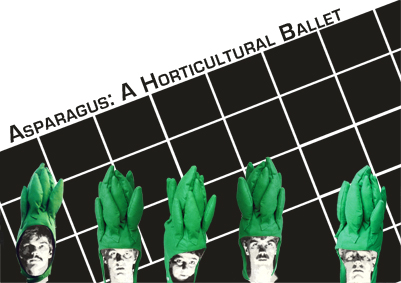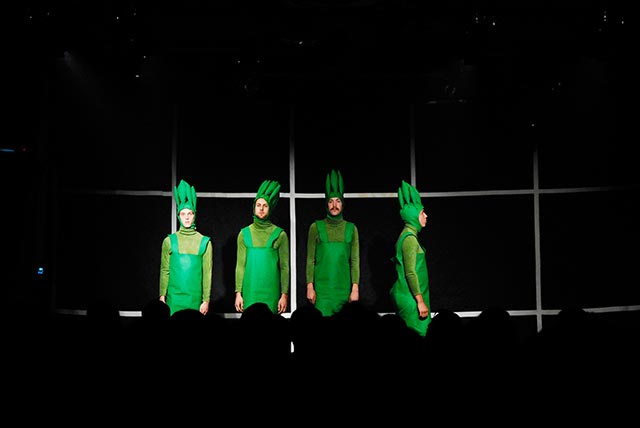Asparagus: A Horticultural Ballet
by Pil and Galia Kollectiv

Being knowledgeable about music sure isn't what it used to be, now that any kid can run a Google search, download on Soulseek and buy on eBay faster than you can say broadband. The elders of punk, who were there in the early days and pogoed all ten of them at the first Sex Pistols concert, those who lost their right arm at Woodstock only to find it ten hours later when the acid wore off - who needs them? It's only a matter of time before a giant iPod descends from the heavens and buries both them and their filthy record collections.
We've come to expect such an immediate conversion of reality to information that it's almost a shock to come up against fragments that don't add up to neatly classifiable discographies on allmusic.com. Nevertheless, every once in a while the primordial cyber ooze conjures up a name that frustrates any attempt to tie it down to any concrete information. In this case, barely a name, just three letters that you are more likely to find on a site devoted to sex with animals or some kind of equally perverse computer programming language than to succeed in relating it back to the band it describes: xex. But even though most of the story of xex seems to have been swallowed up by the black hole that will gradually eat up anything that doesn't find its way into internet code, it is well worth trying to reconstruct it from what little traces of it have survived the digital revolution.
As a result of the disturbing time warp commonly known as the eighties revival, xex's music sounds more contemporary now than it probably ever did when the band was in existence. Certain aspects of it never really went away, and you can sort of recognise them on all kinds of dark/gothic/electro/minimal/synth compilations from the eighties onwards. However, it doesn't quite sound right next to your bog standard post-human, post-apocalyptic theme tunes of despair that usually fill these compilations. Something about the joie de vivre expressed in the face of the impending soviet invasion, or the glee with which the band suggests novel ways of torturing a poor cat, somehow doesn't sit right with the deathly seriousness of their peers.
So where did xex come from? Whatever happened to delete their memory from the collective consciousness that has managed to dig up just about every other forgotten new wave relic in the name of retro? What fate could have brought together two stern looking men, two rather comical moustaches and a lady named Thumbalina to record this strange, Devo-lutionary music in 1980? We originally heard the band on Choking on Cufflinks, Michael Goodstein's legendary radio show on WFMU. In fact, we would not have discovered the Group: Xex album if not for Tom Smith finding it in the station's archive. Having fallen in love with the band's DiY record, obtained after much searching on eBay, we had been trying to reconstruct the mysterious history of Xex, when we were contacted by Mike Appelstein of WFMU, who informed us that he had managed to track down and interview Waw Pierogi, mustachioed founding member of the band.
Miraculously, the story he had to tell was not so far off from the one we imagined, only slightly more suburban, the story of college kids raiding the soundlab and fooling around with early electronics. But it was one detail that really caught our attention: while trying to develop the concept for the ultimate nightclub, the story curious of a vegetal ballet emerged. "Asparagus: A Horticultural Ballet", Pierogi's experimental audio-visual extravaganza, incorporated "a musical composition structurally based on the growth and branching patterns of the asparagus plant, with the compositional structure exposition synchronously with the projection of an animated or time-lapse film of the process of a representative plant's growth, and introducing arrays of rotating hanging baskets of asparagus ferns (to dispel the reception of the piece as serious art with a lowbrow kitsch reference to the rotating disco mirror balls and fern bars of the 1970s) and pirouetting ballet dancers in green headpieces shaped like asparagus spears, reaching the coda: attendants serving platters of freshly cooked asparagus, their movement through the performance space causing its aroma to spread to the multi-sentient performance attendees (who are not limited to being 'spectators' or 'the audience.')".
It soon became clear to us that the asparagus ballet needed to be staged. We had long been interested in the aesthetics of modernism, and when we came across Oskar Schlemmer's Triadic Ballet, it seemed to us to point the way forward for our own asparagus obsession. At the height of modernism, Schlemmer sought to use dance to create a theater of abstraction, exploring the themes of man in space, light in motion and architecture. Like Waw Pierogi's student work, no documentation of Schlemmer's ballet has survived other than a handful of still images, although several attempts at reconstruction have been made. We did not wish to recreate either, but we were intrigued by the possibilities opened up by marrying the ideas left behind by yesterday's art movements, our own interpretations and recombinations hopefully investing them with meanings they never knew they had. In the absence of an original choreography for the project, then, and with no experience of dance whatsoever, we decided we needed to impose an arbitrary structure on it that would dictate the movements. Karl Marx's 'Das Kapital' seemed both obvious and ideal, being itself the story of abstraction, with human relationships transposed by those between commodities and ultimately lose all meaning in the joyless grind of endless accumulation while producing the transcendent mythical figure of capital. Consequently, our ballet narrates the rise of capital in the medium of asparagus. Reading Marx, dada and the Bauhaus backwards, through punk and new wave, we wanted to rescue the humour and critical vitality that have been subsumed by the canonisation and commodification of modernism.
Having collaborated with Les Georges Leningrad on our last film project, we came to discuss the potential for developing the Asparagus Ballet in collaboration with them. Their own music they have often challenged the hierarchies of the historical canon, juxtaposing abstract jazz and modern classical music with contemporary pop and electronics and their unique pertrochemical rock seemed like the perfect complement to our vision of dancing greens. An amazingly dedicated group of art students was recruited to perform the rigid movements in the constricting felt costumes we had constructed.

Asparagus: A Horticultural Ballet, Live at SAT, Montreal as part of the Biennale de Montreal
Jacques Rancière writes in "The Politics of Aesthetics": "Cauliflowers remain cauliflowers, juxtaposed to high rhetoric. They carry no message. They are supposed to enhance political energy out of their very opaqueness...The Brechtian identity of allegory and debunking of allegory supposes that you can play on the connection and the disconnection between art and cauliflowers, politics and cauliflowers. Such a play supposes that vegetables themselves have a double existence: one in which they bear no relationship with art and politics and another where they already bear a strong relationship with both of them. As a matter of fact, the relationship of politics, art and vegetables existed before Brecht, not only in impressionist still life, reviving the Dutch tradition, but also in literature. One novel by Zola, Le Ventre de Paris , had notably put them as both political and artistic symbols. The novel was based on the polarity of two characters. On the one hand there is the poor old revolutionary who comes back from deportation in the new Paris of the Halles where he is overthrown and smashed by the flood of cabbages, meaning the flood of consumption. On the other hand there is the impressionist painter, singing the epics of the cabbages, the epic of Modernity, the glass and iron architecture of the Halles and the piles of vegetables that allegorized modern beauty in contrast to the old pathetic beauty symbolized by the gothic church nearby. The political allegory of the cauliflowers was possible because the connection of art, politics and vegetables, the connection of art, politics and consumption already existed as set of moving borders, enabling artists to both cross the border and make sense of the connection of the heterogeneous elements and play on the sensory power of their heterogeneity". In the end, the music and choreography that has emerged from working on the project have very little to do with xex, Schlemmer, Marx or any of the other references we piled onto the project as it grew to ridiculous proportions in reality and in our heads. But hopefully, it invokes a utopian meeting point where they can co-exist and where timeless knowledge can be replaced by a more dynamic retro-gardism which ransacks the past for future activation.
see more images and live clip from the ballet at Conway Hall.
see a short clip from the asparagus movie.